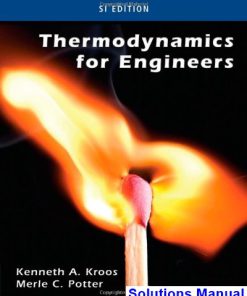Principles of Engineering Thermodynamics SI Edition 1st Edition Reisel Solutions Manual
$26.50$50.00 (-47%)
Principles of Engineering Thermodynamics SI Edition 1st Edition Reisel Solutions Manual.
You may also like
Principles of Engineering Thermodynamics SI Edition 1st Edition Reisel Solutions Manual

Product details:
- ISBN-10 : 1285056485
- ISBN-13 : 978-1285056487
- Author: John R. Reisel
Written in an informal, first-person writing style that makes abstract concepts easier to understand, PRINCIPLES OF ENGINEERING THERMODYNAMICS provides strong coverage of fundamental concepts and applications. To help readers develop a better understanding of how to apply thermodynamics in their careers and a stronger intuitive feel for how the different components of thermodynamics are interrelated, the book asks readers to explore how changes in a particular parameter can change a device’s or process’ performance. Readers are encouraged to develop computer-based models of devices, processes, and cycles and to take advantage of the speed of Internet-based programs and computer apps to find thermodynamic data, just as practicing engineers do.
Table contents:
1. INTRODUCTION TO THERMODYNAMICS AND ENERGY. Basic Concepts: Systems, Processes, and Properties. An Introduction to Some Common Properties. Zeroth Law of Thermodynamics. Phases of Matter. Summary.
2. THE NATURE OF ENERGY. What is Energy? Types of Energy. Transport of Energy. Heat Transfer. Work Transfer. Energy Transfer via Mass Transfer. Analyzing Thermodynamics Systems and Processes. Platform for Performing Thermodynamics Analysis. Summary.
3. THERMODYNAMIC PROPERTIES AND EQUATIONS OF STATE. Phase Diagrams. The State Postulate. Internal Energy, Enthalpy and Specific Heats. Equations of State for Ideal Gases. Incompressible Substances. Property Determination for Water and Refrigerants. Summary.
4. THE FIRST LAW OF THERMODYNAMICS. Conservation of Mass. First Law of Thermodynamics in Open Systems. First Law of Thermodynamics in Closed Systems. Thermal Efficiency of Heat Engines, Refrigerators, and Heat Pumps. Summary.
5. INTRODUCTION TO THE SECOND LAW OF THERMODYNAMICS. The Nature of the Second Law of Thermodynamics. Summary of Some Uses of the Second Law. Classical Statements of the Second Law. Reversible and Irreversible Processes. A Thermodynamic Temperature Scale. Carnot Efficiencies. Perpetual Motion Machines.
6. ENTROPY. Entropy and the Clausius Inequality. Entropy Generation. Evaluating Changes in the Entropy of a System. The Entropy Balance. Isentropic Efficiencies. Consistency of Entropy Analyses. Entropy Generation and Irreversibility. Summary.
7. POWER CYCLES. Introduction. The Ideal Carnot Power Cycle. The Rankine Cycle. Gas (Air) Power Cycles and Air Standard Cycle analysis. Brayton Cycle. Otto Cycle. Diesel Cycle. Dual Cycle. Summary.
8. REFRIGERATION CYCLES. Introduction. The Vapor-Compression Refrigeration Cycle. Absorption Refrigeration. Reversed Brayton Refrigeration Cycle. Summary.
9. IDEAL GAS MIXTURES. Introduction. Defining the Composition of a Gas Mixture. Ideal Gas Mixtures. Solutions of Thermodynamics Problems Incorporating Ideal Gas Mixtures. Introduction to Real Gas Mixture Behavior. Summary.
10. PSYCHROMETRICS: THE STUDY OF “ATMOSPHERIC AIR.” Introduction. Basic Concepts and Terminology of Psychrometrics. Methods of Determining Humidity. Comfort Conditions. Cooling and Dehumidifying of Moist Air. Combining the Cooling and Dehumidifying Process with Refrigeration Cycles. Heating and Humidifying Air. Mixing of Moist Air Streams. Cooling Tower Applications. Summary.
11. COMBUSTION ANALYSIS. Introduction. The Components of the Combustion Process. A Brief Description of the Combustion Process. Balancing Combustion Reactions. Methods of Characterizing the Reactant Mixture. Determination of Reactants from Known Products. Enthalpy of a Compound and the Enthalpy of Formation. Further Description of the Combustion Process. Heat of Reaction. Adiabatic Flame Temperature. Entropy Balance for Combustion Processes. The Gibbs Function. Fuel Cells. Introduction to Chemical Equilibrium. The Water-Gas Shift Reaction and Rich Combustion. Summary and the Limitations of Combustion Analysis.
People also search:
principles of engineering thermodynamics si edition 1st edition
principles of engineering thermodynamics si edition solutions
st thermodynamics laws
principle of engineering thermodynamics
principles of engineering thermodynamics 8th edition solutions pdf












